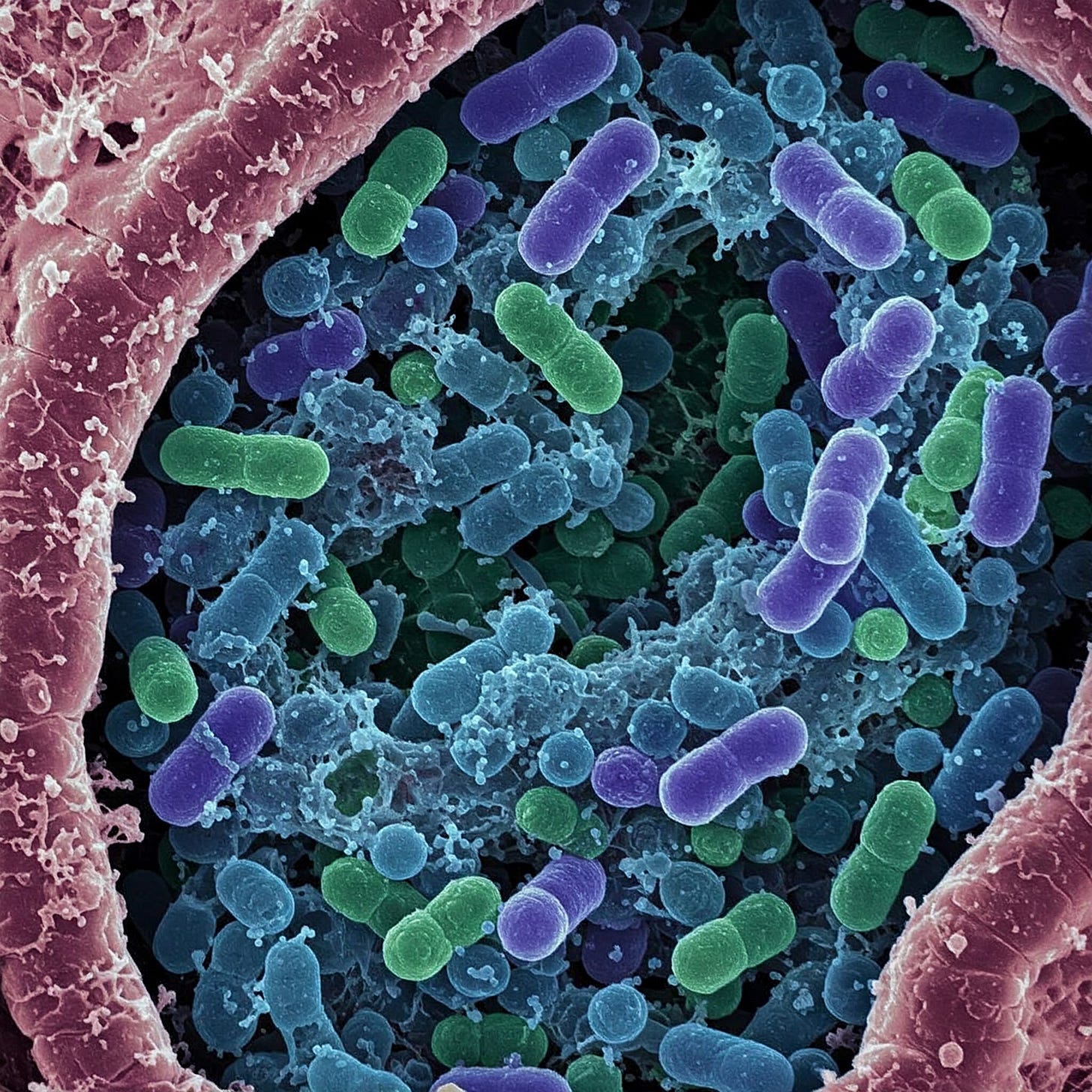Gut Microbiome Research (2025): A Massive Money Pit - Gut Bacteria are a Signal, Not Cause of Most Disease
Gut bacteria correlate with a lot of things... but they are a signal not typically a cause of any medical condition (outside of actual infections).
I am beyond sick of reading the latest hype about the “gut microbiome,” “gut bacteria,” “probiotics,” specific strains of gut bacteria/probiotics, etc. Why? 99% of this research is pure hype with zero substance — and it’s a money pit.
Many very high IQ people have been psychologically captured by the intrigue of “gut bacteria” — taking them down a never-ending correlational black hole.
There are up to ~5000 distinct bacterial species that can be found within the human gut (weighing ~2 kg) and these correlate with all sorts of health/medical conditions.
The problem? Nearly EVERY HEALTH STATUS/MEDICAL CONDITION “correlates” to some degree with abnormal gut bacteria. Correlation does NOT magically equal causation just because it’s interesting.
A very obvious point I need to make: bacterial infections within the gut are real… if you have a pathogen like Clostridium difficile colonizing your gut lining you’ll have abnormal gut bacteria as the definitive “cause” of your medical condition (it’s called a C. diff infection).
But this is not the same as suggesting: diabetes, obesity, cancer, hypertension, depression, autism, dementia, ADHD — you name it — are likely caused by atypical gut bacteria just because there’s some correlation (cuz gut-brain-axis yo).
For most conditions in which gut bacteria correlates with a medical condition — it is either: (1) random and inconsistent (not a true or significant correlation) OR (2) downstream of the condition itself (not the underlying cause).
I’m convinced the writing is on the wall and that funding more “gut bacteria” research (especially “correlational”) is a poor use of funds (bad ROI)… money should be redirected toward practical research (or even highly-specific gut bacteria manipulation interventions.
Other important points to make:
Correlational research: Can be important in some cases. The logic goes as follows: (1) identify correlation of gut bacteria abnormalities with disease X-Y-Z → (2) manipulate the gut to eliminate those abnormalities → (3) determine whether condition improves. If condition improves, the gut probably played some underlying causative role.
Efficacy via gut manipulation doesn’t mean gut is the cause: Just because an intervention that modifies the gut microbiome treats a certain medical condition does NOT automatically mean the gut was the cause. (Ozempic helps treat obesity. This doesn’t mean lack of GLP-1 receptor agonism was the underlying cause of obesity).
Note: Some medical doctors (MDs/GI docs) agree with my perspective but are afraid to speak out because it’s unpopular (there’s not much upside to having this opinion) and there’s potentially downside (populist backlash, going against the grain of the status quo, etc.). Cults have formed around the “gut microbiome” (you’ll find countless anecdotes from people who cured every condition under the sun by “fixing their gut”).
I. The Microbiome Hype Machine
For roughly two decades, the scientific community and popular media alike have portrayed the gut microbiome as a revolutionary frontier in medicine—put forth as the missing key to solving a wide spectrum of health challenges, from obesity and mental health disorders to inflammatory conditions and even cancer.
Research institutions, governments, and private industries have invested hundreds of millions of dollars per year, building new microbiome research centers, funding large-scale initiatives, and publicizing correlations between gut bacteria and nearly every health variable imaginable.
Simultaneously, the global public has been caught up in the so-called “gut health” phenomenon, turning to probiotics, microbiome test kits, and personalized “gut-friendly” diets. Recent estimates suggest that consumer spending on gut-health supplements and probiotics alone may exceed $80 billion per year—a number that continues to skyrocket.
Yet when we scrutinize the actual clinical outcomes of this research spending and consumer investment, the results are surprisingly underwhelming. Outside of a few niche applications, no major non-infectious disease has been reliably reversed or substantially improved by manipulating gut bacteria.
From my perspective: The microbiome appears to be more of an effect of underlying conditions rather than a causal driver—a signal reflecting diet, lifestyle, and genetic predisposition. If that is indeed the case, devoting such a large chunk of scientific resources to correlation-heavy research may be both inefficient and unproductive.
II. A Brief History of the ‘Second Brain’ Hype
Early Foundations (Pre-2000s)
Scientists have known for decades that gut bacteria play key roles in digestion, vitamin synthesis, and immune function.
These studies were mostly small-scale, focusing on clinical safety or rudimentary links to GI disorders. There was little talk of using gut bacteria to treat wide-ranging diseases.
Early to Early-Mid-2000s: ‘Gut Is the Second Brain’
Researchers highlighted the enteric nervous system and its web of neurons lining the gut, coining the term “second brain.”
Preliminary animal and observational human studies suggested that gut flora might impact anxiety, depression, and stress responses. This created a surge in both academic and media interest.
Human Microbiome Project (2007–2012)
In 2007, the National Institutes of Health (NIH) launched the Human Microbiome Project (HMP), with an initial budget of roughly $150 million to define the microbial makeup of the human body.
By 2012, researchers published groundbreaking catalogs of human-associated microbes, sparking widespread speculation that tinkering with these bacteria could be the key to preventing or curing various diseases.
2012–2018: Exponential Growth & Major Claims
Scientific journals dedicated special issues to the microbiome, and every major disease area—from metabolic syndrome to neurological disorders—was scoured for microbial correlates.
Conferences, biotech startups, and labs pivoted to gut-related projects at breakneck speed. Funding agencies welcomed proposals on microbiome “missing links,” fueling further momentum.
Late 2010s Onward: Commercialization & Market Booms
Commercial interests exploded, with microbiome test kits, personalized “gut health” subscriptions, and an endless array of probiotic formulations.
Venture capital investments and university grants grew rapidly; the gut was pitched as a treatable mediator for everything from depression to cancer, despite a paucity of robust, cause-and-effect data.
By the 2020s, many large-scale research papers and clinical trials had concluded with limited or inconsistent success, but the hype and spending continued—buoyed by anecdotal stories and widespread marketing.
Why the Overhype?
‘Second Brain’ Allure: The notion that the gut might control or significantly influence the mind (and body) captured public imagination, prompting dramatic media coverage.
Sequencing Tech Boom: Cheaper, faster genetic sequencing created an avalanche of data on microbial diversity—often overshadowing the challenge of proving clinical relevance.
Intellectual Stimulation: The vast number of potential gut bacterial strains, ratios, etc. are intellectually stimulating and take smart people down correlational “rabbit holes” (sometimes indefinitely).
Commercial Incentives: Academics and industry entrepreneurs saw a potential gold rush; funding agencies celebrated “innovative approaches” to complex diseases.
Placebo & Public Fascination: People eagerly latched onto the idea that a simple probiotic or dietary tweak could fix issues that modern medicine struggled to address.
III. Colossal Research Funding with Poor ROI
By the mid-2010s, national research agencies, philanthropic institutions, and private companies were pouring enormous sums into microbiome investigations.
The rationale was straightforward: if the gut flora truly underpinned so many diseases, we needed to define, sequence, and manipulate it in unprecedented detail.
The problem? Billions of dollars later, broad clinical successes remain elusive outside a couple of GI-related niches.
A.) Government Grants (NIH, EU Frameworks, etc.)
The NIH has been a major supporter, allocating hundreds of millions of dollars annually to projects on the microbiome’s role in everything from cardiovascular disease to mental health.
For instance, a single initiative at Oklahoma State University netted $10.7 million specifically to create a new microbiome research center. Dozens of such grants are awarded each year, quickly adding up.
Return on Investment: Despite hundreds of funded trials and correlation studies, very few have led to consistent or replicated human therapies that significantly move the needle on disease management.
B.) Private Foundations & International Grants
Organizations like the David & Lucile Packard Foundation provide high-value fellowships (often $875,000 over five years) that may go to microbiome projects.
Global Grants for Gut Health, co-sponsored by certain biotech or supplement companies, offer up to $100,000 per project. Similarly, the Microbiome Foundation and others channel philanthropic money into correlation-heavy or pilot mechanistic research.
Repeatedly, these funds often produce observational links—for example, “Gut bacteria are associated with condition X”—without clarifying how to leverage that association into an effective intervention.
C.) University & Institutional Funding
Universities themselves spend tens of millions on new microbiome labs, pilot grants, and graduate student fellowships.
Many institutions have launched specialized “Microbiome Institutes,” replete with advanced sequencing platforms. While technology is impressive, it primarily yields massive catalogs of “who’s in the gut,” with less emphasis on cause-and-effect.
D.) Private Sector & Department of Energy (DOE)
Biotech firms focusing on gut bacteria (for example, probiotic and prebiotic product lines) often raise millions in venture capital. Most aim for quick hits in commercial markets rather than proven medical breakthroughs.
The DOE invests in microbial research for biofuel or environmental purposes—some of which overlaps with gut microbial studies. Tens of millions can be sidetracked into these efforts, further inflating the total.
E.) Overall Cost & Apparent Waste
Conservative estimates suggest that over the past 10–15 years, a cumulative $2–$3+ billion worldwide has gone into microbiome-related studies (not counting the separate consumer supplement market).
The public was promised potential cures or major interventions, yet tangible ROI remains scarce. Except for a couple of GI-specific breakthroughs, the rest largely circles around confirming that unhealthy people have “unhealthy” gut flora—a phenomenon widely recognized but not easily actionable in a curative sense.
ROIC vs. Other Conditions
The ROI for gut microbiome research appears lower than for areas like cancer or cardiovascular research.
While it has led to successes like fecal microbiota transplantation (FMT) for recurrent Clostridium difficile (C. diff) infections (over 90% effective) and some probiotic benefits for irritable bowel syndrome (IBS) and inflammatory bowel disease (IBD), broader applications for conditions like obesity or depression remain unproven.
Much research is correlational, meaning it shows associations but not causation, limiting practical outcomes. In contrast, cancer research, with over $6 billion annual U.S. spending, has produced numerous FDA-approved treatments, improving survival rates significantly.
This suggests gut microbiome research’s ROI is weaker, as it hasn’t translated into many new, widely effective therapies.
Consumer Market Impact
While not directly part of research spending, consumer spending on probiotics and gut health products is massive, exceeding $80 billion yearly, driven by the hype around gut microbiome research.
However, many products lack strong scientific evidence, highlighting a disconnect between research and real-world benefits.
In fact, best-selling author Michael Pollan interviewed top experts in the field of microbiome research about their use of probiotics and most DO NOT TAKE THEM. Instead they focus on healthy whole foods, prebiotic fibers, and fermented foods. (LINK)
Companies like uBiome swindled consumers by promising them special insights from gut microbiome analysis… the problem? None of this stuff was validated, unclear if samples get contaminated en route to the lab, unclear if lab analyses were accurate, and absolutely zero data supports doing this. At one point the company was raided by the FBI.
IV. Correlation Overload: “Signal, Not Cause” Problem
If “diseased gut bacteria” genuinely caused obesity, depression, or autoimmune conditions, we would expect consistent success when attempting to correct that dysbiosis. But most intervention trials come back inconclusive or negative.
A.) Correlation ≠ Causation
Many lauded microbiome discoveries are basically: “We found population X to have more/less of Bacterium Y.”
Instead of driving disease, these microbial shifts typically reflect the disease environment. For instance, if you’re obese or insulin resistant, that metabolic state can select for certain bacteria. It doesn’t necessarily follow that altering those bacteria alone reverses obesity.
B.) A Downstream Signal, Not the Root Cause
Genes, diet, and environment shape body functions, hormones, and immune states—these in turn shape the gut flora. The microbes adapt to the local climate of the GI tract.
Attempting to manipulate the “signal” (i.e., the microbiome) often fails to fix the underlying cause (e.g., poor diet, inactivity, genetic predispositions). Once the intervention stops, the microbiome reverts.
C.) Lack of Successful Clinical Translation
Where correlation-based research is abundant, “gut-microbe therapy” success is elusive. Meta-analyses of probiotic trials in conditions like metabolic syndrome, anxiety, or autism often report no meaningful difference from placebo or extremely small effect sizes.
On the few occasions that a trial shows benefit, subsequent follow-up studies sometimes fail to replicate it, suggesting results may be strain-specific, confounded, or population-dependent.
D.) Anecdotes & Placebo Effects
Patients frequently report feeling better with probiotic or dietary changes, but subjective symptom improvement is highly vulnerable to placebo effects.
What plays into the placebo effect here? High IQ gut microbiome advocates & researchers, MDs (lab coat) buying into the theories, mainstream media/consensus is that gut matters a lot, etc.
Online testimonials rarely control for other lifestyle modifications (like cutting out junk food or adding exercise)—which themselves can alter gut flora and improve health, independently of any targeted microbial manipulation.
V. Any Success from Gut Microbiome Manipulation in Treating Medical Conditions?
Despite my extreme criticism of gut bacteria research, a few medical conditions seem to respond well to gut microbiome modulation.
1.) Fecal Microbiota Transplantation (FMT) for Recurrent C. difficile Infection (Strong Effect)
Recurrent Clostridioides difficile infection is notoriously resistant to standard antibiotics. FMT—which involves transferring stool from a healthy donor—has over 90% success in many trials, effectively repopulating the colon with beneficial or balanced flora that outcompete pathogenic C. diff.
This is a rare success story in microbiome intervention because there is a clear single pathogen dominating the gut. Restoring microbial diversity and outcompeting the disease-causing agent provides a direct mechanism.
2.) Probiotics in Select Cases of IBS/IBD (Mild-to-Moderate Effect)
Some probiotics (e.g., the multi-strain formulation VSL#3) demonstrate mild-to-moderate benefit in irritable bowel syndrome (IBS) or in maintaining remission for ulcerative colitis—particularly if the disease is mild.
Effects are still inconsistent: They don’t cure IBS or IBD, but certain individuals appear to experience symptom relief (less bloating, fewer flares).
Outside these very specific niches, the field has no established, large-scale successes that justify the sweeping claims often made about microbiome manipulation curing or preventing complex systemic diseases.
VI. The Probiotic Market: $80 Billion of Placebo?
While research funding in the microbiome space is staggering, it pales next to the multi-billion-dollar global probiotic industry.
Marketers tout these “beneficial bacteria” as a path to improved immunity, digestion, mood, and more.
I’m not necessarily against taking probiotics because: (A) placebo effects can be legitimately beneficial and (B) certain strains could potentially be beneficial cumulatively (over a long-term) but this is impossible to study; they probably don’t do harm… so on the net you might get some benefit and downside risk is probably minimal.
That said, there’s more evidence in support of prebiotics for gut health (and you don’t need to worry about whether this has any impact).
A.) Massive Consumer Spending
As of 2024, the probiotic market is valued around $71.2 billion, with forecasts suggesting an additional $32 billion in growth over just four years.
This dwarfs budgets for many proven interventions in areas like vaccine development, mental health care, and advanced gene therapy research.
B.) Spore-Based Probiotics & ‘Advanced’ Formulations
Spore-based products are advertised to survive gastric acid and reach the gut intact.
Yet published trials often show minimal shifts in long-term microbiome composition or sustained health benefits.
Many strains simply transiently pass through, failing to establish lasting residence or meaningfully change gut ecology.
C.) Prebiotics vs. Probiotics
Prebiotics (fibers like inulin, fructooligosaccharides) have somewhat better evidence for supporting beneficial bacteria that already exist in the gut. Even then, the effect sizes on significant health outcomes remain modest.
Probiotic claims, in contrast, are commonly overblown, and direct comparisons with placebo often yield inconclusive or negligible benefits.
D.) Heavy Marketing, Weak Results
The average consumer sees glowing testimonials and hears anecdotes about “better digestion” or “boosted immunity,” but large systematic reviews frequently question the robust efficacy of probiotics in healthy populations.
At best, some probiotic use might be beneficial under specific conditions (e.g., post-antibiotic diarrhea, mild IBS). At worst, it’s an expensive placebo that fosters complacency when real lifestyle overhauls are needed.
Note: Many advocate for using probiotics post-antibiotics. However, even this is highly questionable. A study in Cell (2018) reported significantly slower recovery in gut bacteria homeostasis in probiotics users post-antibiotics than those who did nothing. FMT worked very well though.
VII. Gut Bacteria Research: Wasted Time, Intellect, Effort
Gut microbiome research has siphoned away remarkable amounts of scientific talent, resources, and institutional focus—often with limited returns.
The sheer volume of repetitive correlation papers, ambiguous pilot studies, and hype-driven marketing suggests a colossal misdirection of effort.
A.) Opportunity Costs in Science
Correlation-Centric Papers
Universities worldwide are pumping out “Disease X correlates with shifts in gut flora” publications. These papers frequently conclude with an admission that causality remains unproven.
Bright minds—postdocs, PhDs, PIs—spend years generating new correlation datasets or small-scale intervention studies that rarely translate into robust therapies.
Potentially More Fruitful Research Starved
Each $1 million diverted into a correlation-driven microbiome project is $1 million not invested in other medical or scientific breakthroughs (e.g., genetic engineering, novel vaccines, advanced surgical procedures).
This exerts a talent drain too: energetic young scientists might have otherwise pursued more promising avenues.
B.) Repetitive or Redundant Findings
Hundreds of ‘Microbiome Differences’ Studies
Whether it’s obesity, depression, autism, or Alzheimer’s, the story often reads: “We found notable gut bacterial differences in disease vs. control.”
Such studies confirm that many conditions correlate with shifts in the microbiome—but do not illuminate actionable strategies for reversing disease via bacterial manipulation.
Minimal Clinical Translation
Even the best-intentioned pilot interventions—like specific probiotic strains—show inconsistent, modest, or no benefit in follow-up trials.
The literature is thus cluttered with incremental data that do not necessarily stack up to yield a game-changing new therapy.
C.) Costly Infrastructure
Institutional Labs & Cores
Microbiome research often requires advanced 16S rRNA gene sequencing, shotgun metagenomics, or metabolomics platforms—expensive to set up and maintain.
Major institutions have built entire microbiome-focused buildings or core facilities, fueled by grants chasing the “next big thing.”
Data, Data, Everywhere…
The field generates colossal datasets on microbial gene expression, metabolic pathways, and so forth—but practical, replicable treatments remain scarce.
Bioinformatics staff and compute resources are substantial, raising the question: is the cost justified by outcomes?
VIII. Redirecting Funding to More Promising Avenues
In light of the massive sums spent on microbiome research with only narrow GI successes (like recurrent C. diff), many argue we should downscale correlation-heavy microbiome research and reallocate those funds toward interventions that have clearer causal mechanisms or proven efficacy.
A.) Gene Editing & Precision Medicine
Gene Editing
Directly targeting genetic anomalies (e.g., causing cystic fibrosis, certain cancers, or rare diseases) could yield dramatic improvements, whereas gut bacteria manipulations rarely achieve disease reversal.
Precision approaches can rectify root genetic causes rather than tinkering with downstream microbial signals.
Gene Therapy for Metabolic or Immune Disorders
Addressing known gene variants that predispose individuals to diabetes, obesity, or autoimmune conditions is more plausible than adjusting gut flora.
Funding could accelerate clinical trials in gene therapy, bridging gaps between lab breakthroughs and real-world cures.
B.) Novel Surgeries & Direct Therapeutics
Innovative Surgical Techniques
Certain GI conditions (severe ulcerative colitis, Crohn’s disease complications) might benefit from refined surgical procedures (e.g., targeted resections, improved reconstruction methods).
This is more likely to produce immediate clinical benefits than saturating the field with minor probiotic or fiber studies.
Advanced Pharmacology
Building on hormone-based therapies (like GLP-1 agonists in type 2 diabetes) directly modulates appetite, insulin sensitivity, and metabolism—demonstrably effective interventions that do not rely on uncertain changes in gut flora.
These routes have established mechanistic clarity, making them prime targets for additional R&D investment.
C.) Synthetic Gut Hormone Modulators
Tapping the Gut Endocrine Axis
Rather than introducing random microbial species, systematically manipulate gut hormone secretion or receptor activity to control specific disease parameters (e.g., appetite, GI motility, immune responses).
Example: Semaglutide and other GLP-1 analogues are major breakthroughs for obesity and diabetes, bypassing guesswork with microbe compositions.
Evidence-Based Development
Trials of gut hormone modulators yield straightforward endpoints (e.g., weight loss, A1C changes), offering clear benchmarks of success or failure.
Compare that to microbiome-based therapies, where success or failure is often muddied by confounding factors (diet, genetics, placebo effects).
D.) Combating Antibiotic Resistance
Phage Therapy
Bacteriophages precisely target harmful bacteria. This is a direct microbiological intervention with a plausible mechanism, potentially replacing broad-spectrum antibiotics.
Unlike correlation-chasing in gut dysbiosis, phage therapy is a targeted solution for actual pathogens causing disease.
Novel Antimicrobials & Stewardship
Funding for new antibiotic classes or stewardship programs addresses a clear-cut crisis in public health: antibiotic-resistant infections.
This directly tackles microbes that truly cause disease, not indirectly “associated” communities.
IX. Potential Future: Engineered Biotics
While the prevailing view is that microbiome research has been overhyped, some specialized or next-gen approaches remain intriguing—provided they undergo rigorous testing and clarify causal mechanisms.
A.) Genetically Engineered Probiotics
Tightly Controlled Functionalities
Instead of tossing in random “beneficial” bacteria, researchers can design strains with specific therapeutic actions (e.g., producing certain vitamins, neutralizing toxins, or emitting short-chain fatty acids at controlled levels).
Analogy: The “Lumina” concept for oral bacteria that outcompetes cavity-causing species, but adapted for the gut to address localized infections or inflammation.
Safety & Regulatory Hurdles
Engineered microbes must undergo strict regulatory pathways to ensure they don’t introduce antibiotic resistance genes or disrupt host ecosystems in unforeseen ways.
Long-term colonization and horizontal gene transfer present complex safety questions.
B.) FMT-Mimetics
FMT Without the Risk
A rational goal: replicate fecal microbiota transplantation’s success in C. diff without using raw donor stool. “Mimetics” would be curated consortia of microbes or synthetic cocktails that can displace pathogens.
If proven safe and standardized, this approach could reduce infection risks and contamination issues seen with direct stool transfers.
Downside: Limited Scope
Even if FMT-mimetics are perfected, they’d likely remain a narrow solution for infections or localized GI issues—not a universal fix for systemic diseases like obesity, depression, or autoimmune disorders.
C.) Careful, Targeted Trials
Avoid the Correlation Trap
Any future interventions in engineered biotics must demonstrate clear causal pathways—like inhibiting a specific pathogen or modulating a well-understood immune pathway.
We need well-designed RCTs that measure concrete endpoints, not soft claims or correlation data.
Potential but Not Guaranteed
While these technologies sound promising, breakthroughs will require substantial and targeted effort. Given the microbiome field’s track record, skepticism is healthy until robust data emerges.
X. Gut Microbiome Research Needs a Reality Check
This is my perspective on gut microbiome research. I think a lot of really smart people are wasting time, money and intellect that could be better used elsewhere.
Really the only exception is if someone is working on an innovative synthetic/next-gen gut manipulation intervention that is safe and effectively treats a condition. But the correlational garbage needs to stop.
A.) Money Sink, Limited Returns
After over a decade of lavish funding, the gut microbiome field has produced few consistent, effective therapies beyond:
FMT for recurrent C. diff
Some adjunct probiotic benefits in mild IBS/IBD
For the countless other diseases it was supposed to revolutionize—like obesity, type 2 diabetes, depression, autism, and more—robust, repeated successes are conspicuously absent.
B.) Mostly a Signal, Not a Cause
The dominant narrative that gut microbes are the hidden “puppet masters” of human health overlooks evidence that microbes adapt to conditions shaped by genes, diet, environment, and lifestyle.
Fiddling with the microbiome alone seldom solves underlying health problems.
My take is that for most people/conditions (other than direct GI infection) — gut bacteria abnormalities are downstream of the actual condition or completely unrelated (not directly causing it).
C.) Should we still fund gut research?
Yes. I don’t advocate for throwing the baby out with the bathwater in this niche. However, we should be focusing on high-impact, innovative research — not: What new correlation can we find today in a C57/BL6J mouse model of obesity?
Maintain modest, targeted research aimed at engineered interventions (e.g., synthetic gut-hormone modulators, carefully designed bacterial strains).
Cut or severely limit funding for correlation-based, scattershot microbiome projects unless a compelling rationale is demonstrated (e.g., a new approach to antibiotic-resistant infections).
D.) Buyer Beware (Probiotics)
The $80+ billion probiotic market thrives on anecdotes, marketing, and placebo. While certain situations may warrant probiotic use, the majority of claims remain unsubstantiated in rigorous clinical trials.
A better approach: diet and lifestyle improvements that naturally shift the microbiome to a healthier profile, rather than hoping a pill can do the trick.
Verdict
The gut microbiome research industry—as it stands—is a bloated domain of hype and overpromising. Dollars spent might be better allocated to fields with mechanistic clarity, direct disease targets, and proven interventions.
Without a major shift from correlation mania to genuine, high-quality intervention research, this domain risks continuing as a money sink with negligible returns.
XI. Addendum: If I’m Wrong…
I would love to be wrong here… just don’t think I am.
Eager to Be Proven Otherwise
If, down the line, robust human trials show that a specific microbiome manipulation cures a major disease or confers significant health improvements, this critique will need revisiting. (This is plausible to me but it won’t be from your run-of-the-mill probiotic supplement.)
Genuine breakthroughs would redeem parts of the earlier research or highlight newly discovered mechanisms.
State of the Evidence (Current)
At present, the track record suggests that ramping down broad microbiome research is the prudent path until more definitive, replicable, and clinically impactful studies emerge.
The field can still move forward in specialized niches, but the prevailing approach—endless correlation and hype—should be pared back in favor of productive interventions in other medical domains.
Closing Remarks
Gut microbiome research exploded on promises that it was the “second brain,” controlling countless aspects of human health. Over a decade of intense study and billions in funding later, the grand vision of curing or preventing non-infectious diseases via gut bacteria remains largely unrealized.
While a measured level of targeted microbiome work is still warranted (e.g., specific infections, engineered strains), the bulk of correlation-driven investigations have yet to offer a satisfactory ROI.
The practical move: prioritize direct, mechanism-driven therapies—gene editing, improved pharmacology, advanced surgeries, and validated microbe-focused techniques—rather than continuing to chase tenuous microbiome correlations.
What can you do to improve gut health (gut microbiome)?
Use common sense. If you make reasonably healthy lifestyle choices, your “gut” should be fine without the need for probiotics. There’s nothing necessarily bad about taking them (and could be some upside), but you don’t need to overthink it.
You can find many healthy people with completely different gut microbiome compositions based on environment and diet (the bacteria adapt to environment, what you regularly eat, habits, etc.). Someone doing “keto” will have different gut bacteria than someone doing high carb.
Most people with long healthspans/lifespans aren’t obsessing over whether they remembered to take probiotics. They just have a balanced lifestyle and favorable genetics.
Healthy level of body fat: If possible. By any means. Don’t care if through calorie tracking, Ozempic, whatever. Too much fat causes gut bacteria abnormalities.
Prebiotics: Prebiotics have more evidence supporting use. Probiotics usually don’t survive the GI tract, but some might. Could try kombucha or kimchi or whatever too. No need to go overboard though. Synbiotics combine pre/pro-biotics for a synergistic effect.
Fermented food: Many gut researchers swear by including some fermented food in one’s diet. Whether this generates favorable long-term health effects is unclear. It might, it might not… might be neutral. Nobody really knows.
Exercise regularly (cardio): Can enhance gut bacteria composition.
FMT as an option: Seems to help severe/recurrent C. diff infection. If your gut bacteria are likely way out of whack, FMT could be something to consider with expert/specialist assistance. Just know the risks.
Stress, sleep, lifestyle: The obvious stuff. Managing stress, getting enough sleep, healthy lifestyle = better gut composition.












